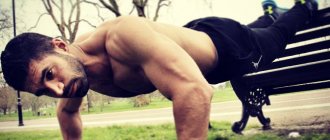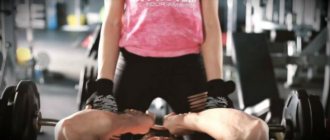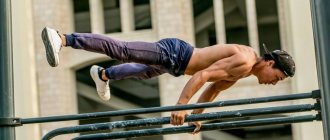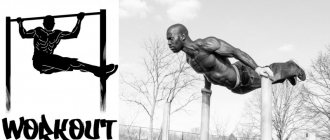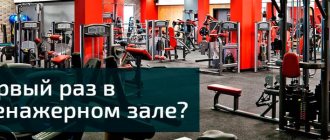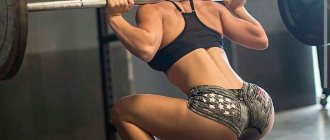The front hang is one of the toughest and toughest elements in street sports. It is performed while maintaining a static horizontal position of the body. To do this element, you need to grab the bar with both hands and, without bending them at the elbows, bring your body to a horizontal position relative to the ground. Everything seems to be very simple, but only at first glance. Personally, I love this element, it gives the impression that the person is suspended in the air! Judging from the point of view of the difficulty of learning the element, I would put it between “Flag” and “Planch”.
Front hang with bent legs.
The easiest initial stage in learning a full hang is a front hang with your knees tucked to your stomach.
Firmly grasp the horizontal bar and, tucking your legs, bring your body to a horizontal position, try not to bend your arms or lower your body to its original position. Hold this position for as long as possible, making every effort not to fall down. A more difficult option is to stretch one leg while the other remains pressed to the stomach. At first, I advise you to not straighten your leg completely, watch the technique, the body should be strictly horizontal. If you are doing great, then feel free to straighten your other leg.
Bodyweight exercises
There are many different exercises that are performed by using your body weight. To implement them, the simplest of sports equipment are very often used: horizontal bar, parallel bars, etc. These exercises will also help you develop strength and endurance if done regularly.
Depending on the complexity of execution, these exercises are divided into different types. Some of them are suitable for beginners and do not require special training, while others are impossible without a period of preliminary training. The second category includes many exercises with your body weight on the horizontal bar, especially the front hang.
Rocking.
This method of studying the front hang comes down to bringing the body to a horizontal position but not statically holding it at the end point. Firmly grasp the bar, tense your entire body, inhale, and then try to perform a front hang, hold for 1-2 seconds and lower your legs to the starting position. Do this exercise slowly; at first you may not be able to bring your legs to a horizontal position, but constant practice will allow you to strengthen your torso. Work on yourself and you will succeed. Number of repetitions 8-15.
Why hang on the horizontal bar?
There are several reasons to incorporate the pull-up bar into your workouts or simply do them throughout the day.
Strengthening your grip strength
Grip strength is necessary for many movements with your own body weight: pull-ups, leg lifts to the horizontal bar, exercises on gymnastic rings, climbing ropes or holds.
Sometimes it is weak muscles in the forearms and hands that limit the number of repetitions - you could do more, but your fingers slip off the bar. This is not only offensive, but also dangerous.
View this post on Instagram
Posted by Josh Pirtle (@fluffy__duck)
A strong grip is also useful in sports such as weightlifting, powerlifting, crossfit, kettlebell lifting, and bouldering. Hanging on a horizontal bar is also a good lead-in exercise for pull-ups: it helps strengthen the forearms, hands and shoulder girdle muscles.
Maintaining Shoulder Health
In a YouTube video on the Bob & Brad channel, physical therapists Bob Schrupp and Brad Hynek explain that hanging from a pull-up bar can relieve limited shoulder mobility by stretching the coracoacromial ligament.
Stiffness of this ligament can lead to narrowing of the subacromial space, impingement syndrome, and a decrease in the range of motion of the shoulder joints. Brad Hynek claims that hanging from a horizontal bar allows you to stretch it, increase shoulder mobility and get rid of pain.
Relieving stress from the spine
We couldn't find any research on this, but some orthopedists say this is true.
For example, on the website of a manual therapy clinic in Los Angeles they say that hanging on a horizontal bar relieves stress on your back. During it, the latissimus muscles stretch and slightly expand, which reduces pressure on the spine, increases the space between the vertebrae and improves nutrition of the intervertebral discs.
Hanging on a horizontal bar is also mentioned as a method of spinal decompression on the website of the Canadian clinic Yorkville Sports Medicine from Toronto. An article on this topic claims that the exercise helps reduce pressure on the spine and nerves by increasing the space between the vertebrae.
Orthopedic surgeon Beth Terranova from New York also advises hanging on the horizontal bar. In an article on POPSUGAR, Terranova explains that our spine is under pressure from gravity all day long, and the hang helps counteract the pressure accumulated throughout the day.
Warming up your muscles before exercise
Active hanging on the horizontal bar can be included in your warm-up - as a way to prepare the muscles of the shoulders and back for stress. While raising and lowering your shoulders while hanging on the horizontal bar, almost the entire shoulder girdle works.
In addition, the muscles are not only loaded, but also stretched, increasing the range of motion of the limbs. This is especially good for those who suffer from a lack of shoulder mobility.
Practice, practice, practice.
As I said above, only constant practice and work on yourself allows you to achieve good results in sports. The work of learning the front hang is the most painstaking work I know. Studying this element may take you a lot of time and effort, so decide whether you need it? If you answered YES to yourself, then be patient, gradually increase the pace, hold the hang confidently for a couple of seconds and only then start adding seconds. I knew one guy who, until he was blue in the face, held his head bent at the waist and his arms bent; his position was comical, but it seemed to him that he was straight! LoL
In no case should the front hang be a panacea; continue to do pull-ups and push-ups; success in mastering this element depends on them.
I also recommend that you do jogging or breathing practices. The fact is that any static posture causes tension in the body and, as a result, makes breathing incomplete or eliminates it altogether. In this mode, your heart cannot work for a long time, so to avoid complications, try to do cardio exercises after exercises such as flag, front hang, back hang. I'm not talking about jumping off the horizontal bar and running a 5K, but tomorrow morning I would advise you to do it. Spend more time on this element and you will succeed, good luck! Translation:
Dmitry (
www.bar-family.ru
).
Vis[edit | edit code]
Perform hang
- not an easy task. Even if you become a master of pull-ups and power-ups, you may spend months or years before you can do a quality hang.
And it’s better to truly love bodyweight exercises, otherwise there will be a great temptation to deviate from this path. Only those who have a passion for developing bodyweight strength should go further.
Vis (especially the front)
is one of the most difficult bodyweight exercises. It requires incredible core strength as well as powerful upper body muscles. Training this movement develops tremendous strength in the arms, chest, back, and abdominal muscles. Hanging also teaches you how to work your muscles in a complex manner, allowing you to use them in the most efficient way. Let's see how different types of hangs are performed on the horizontal bar.
Rear hang "swallow"[edit | edit code]
Man has not yet learned to fly without planes and helicopters, but he is quite capable of performing a rear hang “swallow”! It will help develop strength throughout the body while allowing you to get used to the feeling of being suspended. The back hang swallow is a fun, functional exercise, and it looks amazing!
Rear hang "swallow" at a large angle[edit | edit code]
You can perform a back hang “swallow” by moving your legs back under the bar from a pull-up position, as in the “sun” exercise. Once your feet are on the other side of the bar, straighten your entire body so that you are hanging completely face down. The legs will cling to the bar on top, and the body will be under it.
From this position, you want to bring your body parallel to the ground so that your hips are directly under the bar, so push your chest forward as you lower your legs. This exercise allows you to work your abdominal muscles and stretch your back. Try also actively pulling your arms down towards your hips, using the latissimus dorsi, triceps and chest muscles.
The back hang “swallow” can be performed with either a forward or reverse grip. It's also a good idea to use a relatively narrow grip, as this allows you to transfer some of the weight to your hands. Try squeezing your lats and triceps at the same time to keep your torso straight and high, pulling your abs in, squeezing your glutes, and squeezing the back of your legs.
It's helpful to have someone watch or film you while doing this exercise, as it will be difficult to sense when you're in the right position. As always, the key is to tense your entire body. When performing the back hang “swallow”, do not forget to contract the abdominal muscles, lower back, muscles of the back of the thighs and buttocks. Your hands are only part of the equation.
Back hang “swallow” with legs bent at the knees[edit | edit code]
If you perform the rear swallow hang with your knees bent, it will be a little easier, and beginners will be able to get a feel for this exercise. Apart from the bent legs, all other elements of the rear swallow hang are unchanged.
Front hang[edit | edit code]
Front hang
- This is one of the most difficult and at the same time effective exercises in calisthenics. It can be performed both in a static position and in the form of repetitions from a vertical hang. The front hang involves pulling your entire body forward so that it is parallel to the floor, much like lying down... but in the air!
Front hang with tuck[edit | edit code]
The simplest front hang variation is the tucked front hang.
. Hang from the pull-up bar and tuck your legs toward your chest, pushing your hips back so that your body is parallel to the ground. Try to keep your body straight and remain in this position for as long as possible.
Pull-ups in a straight hanging position with a tuck[edit | edit code]
Once you can hold a tucked front hang for at least 10 seconds, you can try doing tucked front hang pull-ups. It's best to do this on the parallel bars you normally use for push-ups. Hang on them so that your body is under the bars, bring your knees to your chest and group your hips in the desired position. As you pull up, make sure to keep your hips up. Think of it like an advanced version of the Australian pull-up.
Front hang with semi-tuck[edit | edit code]
In the next tuck front hang variation, you will need to straighten one leg. Everything else remains unchanged. Once you are able to do 10 clean push-ups in a front hanging tuck position, you can try doing pull-ups in that position.
Front hang with legs spread[edit | edit code]
By spreading your legs during a front hang, you not only shift your balance point, but you also shorten the lever, which makes a full front hang a little easier (although this exercise is still more difficult than a tuck or semi-tuck hang). To perform a good front hang with legs apart, you will need good hip mobility, so be sure to stretch regularly.
Counterweight[edit | edit code]
As you get stronger, you should make the exercises more difficult. The most common way to do this is to add weight. The front hang is one of those rare exercises that actually gets easier as you add weight. If you wear a light backpack (about 5-10% of your body weight), it will actually help maintain your balance in this position. Plus, it looks cool!
Front hang for reps[edit | edit code]
When working on the front hang, it is useful to do repetitions. Tighten all the muscles in your body as you lift your torso with your latissimus dorsi into a hanging position, then lower back to a vertical hanging position and repeat.
When you get tired, start raising your legs while hanging.
This will perform a very difficult superset.
Tighten all the muscles of your body, lifting your body with your latissimus dorsi into a hanging position...
Front hang with transition to power lifting[edit | edit code]
Front hang with transition to power lifting
- A great way to improve the front hang, and in itself it is the coolest movement. At first it will be easier to perform a power lift and then lower yourself to a hanging position, all the while tensing your body muscles. While holding this position, pull yourself up and lift your body over the bar, then repeat. When performing this maneuver, try working with a false grip.
One arm hang[edit | edit code]
One arm hang
It's not often seen, but this extremely advanced hang variation is possible for those who are willing to work hard at it. Exactly the same as the rear hang “swallow” on one arm. When attempting variations like this, remember that your body has to rotate a little to find its balance point. I would give you a couple more practical tips, but I still have some work to do here myself!
Crocodile hang on elbows[edit | edit code]
This is one of the few exercises that is not performed on a bar, although, like the handstand, it can be done on a bar if you have the confidence and preparation. As the name suggests, the crocodile hang is performed using one or both elbows and balancing on the arm(s), with the body extended in a horizontal plane. Although the alligator hang is similar to a gymnastics plank, it is less challenging due to the fact that the upper body rests on the arm(s).
Although the alligator hang can be performed on a variety of surfaces, it is recommended to start with a bench, step, or other flat, elevated object. This will allow you to grip the object by curling your fingers over its edges, which is easier for many than using a flat grip.
Another advantage of working on a bench is that it gives you more space to get your legs into position, as opposed to working on the floor, where you have to start the exercise in a confined space with your hands on the floor. You have more wiggle room when playing with balance.
Be sure to tense your abdominal and lower back muscles as you get into the desired position. It is also important to bring your upper body forward to counterbalance your lower body. You will probably have to extend your elbows more than 90° to get into the desired crocodile hang position. Notice the elbows and hands in the photos below.
When training the crocodile hang, you should rest your elbows on your pelvic bones. Try to tighten your core muscles as much as possible as you move into this position, as your elbows will inevitably rest partially on your stomach. It may take time to get used to the feeling of your elbow on your stomach. This feeling is especially unpleasant for beginners. However, with practice you will finally get used to it.
Since the alligator hang trains the skill of balancing on your hands, this exercise can also be useful when training a two-arm handstand without support. This is a good transition exercise between toad and handstand.
Crocodile hang on one arm[edit | edit code]
Although breakdancers and other experienced hand-balancing acrobats can do a one-arm crocodile hang with seemingly no effort, the exercise is an extremely difficult trick, so if you want to try incorporating it into your arsenal , please be patient.
As with the two-arm variation, begin the exercise by simply trying to lift your feet off the ground to gain balance before fully extending your body. At the very beginning, it is useful to secure yourself with your free hand, extending it to the side and resting several fingers on the surface you are balancing over. You can remove your hand from this position for a second to briefly feel the entire exercise, and one day you will be able to remove it completely.
There are a number of nuances when performing the crocodile hang on one arm, which are unique to him. First, it is helpful to turn your body slightly away from the ground to avoid falling over on your other side. It is necessary that the weight is distributed equally on both sides of the hand.
In addition, if you form a triangle with your body, spreading your legs apart, it will be easier to find balance. Gradually you will learn to stretch your body into a straight line.
The master's work is afraid[edit | edit code]
Many people can quickly master the crocodile hang, but training the front hang will take much longer. Be patient and gradually increase the duration of the hang to a few seconds each time you are about to master a new variation. If you find yourself stuck, take a break from hanging training and continue working on the basic exercises, then return to hanging again after a few weeks. In fact, taking a short break from practicing difficult skills can sometimes give you a fresh perspective.
Author: Al Kavadlo
Benefits of workout
Workout has a number of advantages over classic fitness. Namely:
- This is interesting. In workout there is something to strive for, something to motivate yourself with, besides the appearance of your body. This type of physical activity is suitable for those for whom it is not enough just to look good, but it is also important to get drive and enjoyment from the activity.
- This is impressive. Workout, combining gymnastic and strength moments, is a truly spectacular form of amateur sport. Having overcome the initial difficulties, you will be able to impress not only yourself, but also those around you with your skills.
- Availability. To practice workout, it is not necessary to rent a gym; it is enough to have access to an outdoor sports ground. For training you need parallel bars, a horizontal bar, a Swedish wall - often this is enough. And training programs are available online; below we will look at some of them.
- Workout develops not only strength indicators, but also overall control of your body. For example, this training contains many elements aimed at maintaining balance and stretching - more than in classical fitness.
- It's more complicated. But in some ways it’s more interesting. You can always set a goal for yourself that you have an incentive to strive for. Workout classes develop healthy patience and the ability to work for results.
a spectacular sport that combines strength training and gymnastics
There is one drawback of this type of physical activity compared to fitness. Many elements are very complex and require lengthy preparation. It’s much easier to just sign up for a gym, do standard exercises, and after a while you’ll see the relief you’ve drawn. However, if you are not afraid of difficult tasks, and difficulties only spur you on, then you will not regret choosing workout.
Workout for beginners, program + video
Another important rule that beginners often forget about is warming up all muscles and joints before training to avoid clogging, injuries and micro-tears. The recommended interval between workouts is approximately 48 hours, which is how long it takes for muscles to recover. Many workout athletes train daily with the onset of good weather, but still try to conduct classes every other day.
a sport that can be practiced in open areas
The training program for beginners is designed for all muscle groups at once.
An approximate program for very beginners would be:
Monday:
- Swinging on the horizontal bar.
- Push-ups on parallel bars 20 times, 3 sets.
- Classic squats 20 times, 3 sets.
- Hanging leg raises.
Wednesday:
- Classic squats.
- Pushups.
- Hanging leg raises.
- Wide grip pull-ups.
Friday:
- Wide grip pull-ups.
- Dips with a straight body.
- Push-ups with wide arms.
- Hanging leg raises.
- Swinging on the horizontal bar.
Sunday:
- Wide grip pull-ups.
- Dips with a straight body.
- Classic squats.
- Hanging leg raises.
If some exercises do not work out right away, you can use special devices. For example, grip straps or an expander to make pull-ups easier. This will allow even a beginner to complete the entire training program.
Video: Workout program for beginners
How often and for how long to hang on the horizontal bar
The hanging time and frequency of classes are determined by the goals set:
- To relieve back strain or increase shoulder mobility. Perform three sets of passive hanging for 10 to 60 seconds, with 60 seconds of rest in between. You can additionally rotate your pelvis from side to side, twisting your body. Do the exercise two to three times a day.
- To improve your grip strength. Set a timer for five minutes, get into a passive hanging position and hold for as long as you can. Then jump off, shake your arms, and hang back on the bar. Continue until the end of the five-minute interval. Do this exercise once a day, for example in the morning.
- To warm up before training. Perform 10 repetitions of alternating active and passive hanging, rest a little and do five repetitions of hanging shoulder rotations forward and backward. Rest again and complete the warm-up on the bar with 10 reps of swinging hangs.
- To prepare for pull-ups. Do three to five sets of alternating active and passive hanging 10–12 times. Use in combination with other muscle-strengthening movements: negative pull-ups, pull-ups with an expander, lat pull-downs.
Workout program for girls
Workout is more common among guys, but this type of activity is also suitable for girls. There is a myth that when doing workout, a girl will acquire a masculine silhouette. In fact, such fears are unfounded: workout will help to evenly pump up the muscles of the whole body, develop endurance and flexibility, but it will not be possible to build up excess muscle mass due to hormonal characteristics. Women of impressive size, as a rule, take appropriate medications.
Girls should follow the same rules as boys. Muscles need recovery, so you should exercise every other day, giving yourself time to rest.
Workout helps girls develop an excellent figure
A training program for girls may look like this:
Monday:
- Swinging on the horizontal bar.
- Dips.
- Angle bars or hanging leg raises.
- Hanging on one arm (one at a time, for a while).
Wednesday:
- Squats with wide legs.
- Pushups.
- Hanging leg raises.
- Medium grip pull-ups.
- Combination: make a corner and sit on the bar.
Friday:
- Swinging on the horizontal bar.
- Hanging with leg raises.
- Dips.
- Corner.
- Hanging upside down.
Sunday:
- Pushups.
- Bulgarian lunges.
- Jumping on a step.
- Classic pull-ups with a straight grip (beginners can rest their feet on a wall bars).
- Plank.
Hanging leg raises - what muscles work?
Leg raises are a complex and multifaceted exercise aimed at strengthening several muscle groups at once. The exercise is classified as basic training and is often recommended for general strengthening of physical fitness. The main load goes to the following muscles:
- rectus and oblique abdominal muscles;
- iliopsoas region;
- rectus femoris muscle (the main flexor of the leg when walking.
First of all, the lesson is aimed at the abs, strengthening them and tightening the abdomen. The stabilizers are:
- lower trapezius muscles;
- serratus anterior and rhomboid muscles;
- shoulder rotators, dorsal muscle groups.
The main load on the abs begins after raising the legs above the horizontal position, so you need to carefully adhere to the technique to obtain the desired result.
